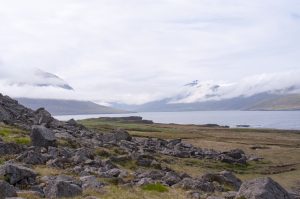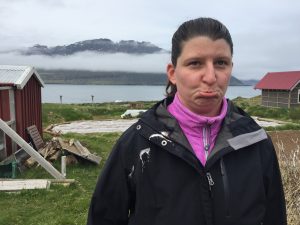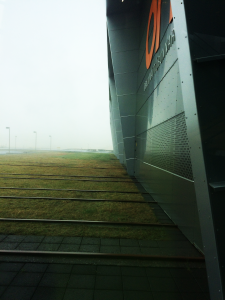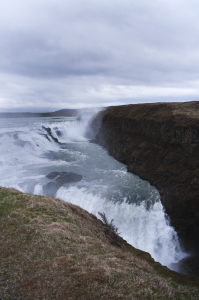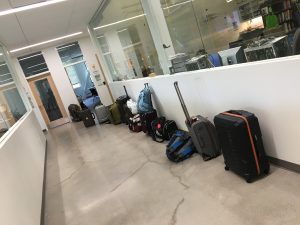Cold, wet and cold. Constant rains at Skalanes, indoor science is not as exciting as outdoor science. Ventured out into the as little as possible. Once to place and geo-reference survey stakes, and once to track the elusive Gandolf. He is a master escape artist and a speed demon. Gandolf is a domestic rabbit that escaped/was released near the house at Skalanes. The first few attempts on his capture involved many hands and quick feet. However in the past few days I have tried a different approach. Slow and steady trust building. I have successfully had him eat out of my hand on two separate days. the rains today slowed the efforts. I hope day three will bring full success. Since we could not fly the drone and decided to wait on soil samples we decided to do a bit of group bonding, many rounds of Euchre and Coup past the time. Even in the rain this place is gorgeous. I can’t wait to get outside and do some more exploring!!
Settling in at Skalanes: Home away from home
It feels good to be settled for a bit after several long days of travel. And what a place to settle. [Audible deep breath in…and out]
Since we are here for some time and there is much work to be done, we started our day by organizing science gear and planning the research we will do here on the property as well as some of the experiments we will perform on soil samples we collected at Solheimajoekull glacier. Our group has also settled into a nice cooking and chore rotation.
After lunch today, Oli and Rannveig took us on a walk to the cliffs east southeast of the house. Oli shared with us the history of Skalanes, information about the bird colonies here, and the role that lupine plays in fertilizing the soil in Iceland.
We saw lots of fulmars, a type of ocean bird; kittiwakes, a type of gull; and puffins, adorably cute. We have been enjoying the unique sounds of the snipes, discovered that male eider ducks make sounds similar to owls, and we’ve been trying to steer clear of the Arctic terns as they work to protect their nests. I am still researching which bird pooped on me as we began our walk. [Note: this is the second time a bird has pooped on me while on a trip with Charlie; at least we weren’t on our way to visit Earlham alumni and donors this time!]
While Skalanes hosts student and faculty scientists and outdoor education enthusiasts like our Earlham group, it also relies on tourism. Today, we enjoyed welcoming a group from a tour boat who came to hike a bit, take in the views of the fjord and the cliffs, and do some birding.
Tonight, several are enjoying the sauna before a full day of science tomorrow. I’m heading to the showers. I think it was the tern.
Save
A ferry, a climb, and a feast!
The day began bright and early (and misty) to catch an hour long ferry ride to Heimaey. Thankfully, our stomachs allowed for a relaxing journey with the opportunity to spend time on the deck or stay inside for a short nap. Upon arrival, we were greeted by faint smell of fish and the sound of birds who were circling the many cliffs surrounding us.
Our first stop was the lowest spot in sight- the docks, where we calibrated the Ambiance Platform device onto the application, Field Day, developed by the Earlham CS group. This was then able to track our movements throughout the island as we split into two groups to hike the volcanoes, Eldafell and Helgafell. The scree made our hike challenging, but after pushing through, we were rewarded with a beautiful view of the town as we reached the top and collected the points of highest elevation.
As we returned to town, there was time to freely explore the streets, shops, and museums. Before heading back on the ferry, we were treated to a mouthwatering dinner at GOTT, a highly reviewed favorite of Charlie’s.
Day one on the Solheimajoekull glacier
Today we drove from Reykjavik to the Solheimajoekull glacier on the south coast of Iceland to take soil samples and try-out flying our remote piloted aircraft (AKA drone). Groups of Earlham students & faculty have been working here for a couple of years measuring the shrinking extent of the glacier and taking soil samples on which we do 16S rRNA sequencing to characterize the development of soil microbes as the soil develops after being exposed by the receding glacier.
The red circle on the image is the area we work in, for a sense of scale the circle is about 2km in diameter.

This picture was taken from the ridge on the East side where we were sampling. We are almost always wet and cold when we are working here, but all a person needs to do is look around and take in the amazing view to feel pretty good about being there.

After finishing we piled back into our vehicles and drove to Vik where we will be staying for the next two days. Emi made a great dinner for us and now we are organizing the samples and data we collected today. Tomorrow we go to Heimaey, an island off the South coast to hike the two volcanoes located there and test our new elevation platform.
Eggs, Fog, Geothermal, and a Waterfall
After a much needed night of sleep, we began our second day in Iceland! We woke up to a 5-star breakfast, omelettes, courtesy of Charlie. After breakfast we hopped in the cars and were off to Hellisheiði Geothermal Power Plant for a tour. The van missed its turn due to some extreme fog, but eventually we all made it! At the plant got to learn about how geothermal power is generated and how the plant sends the hot water and power it produces to everyone in Reykjavik.
After the tour, it was back into the fog for a drive to the waterfall, Gullfoss. Gullfoss is a popular waterfall in the canyon of the Hvítá river in SW Iceland.
We ended our excursions with a delicious dinner of Tikka Masala, prepared by Ai Lena and Jacob!
And so, we landed!
Today marks our fist day here in Iceland.
Events started in a bit of a disarray with the airlines misplacing some important biology items and Charlie attempting new fashion trends,
but nevertheless after collecting our things from the baggage claim we soon found the members of our group who had arrived ahead of the main party. 
Dan was our fearless leader of the day and we organised into groups to get some errands done such as getting an emergency SIM card, going grocery shopping, and getting dry ice. At this point everyone was feeling the effects of tiredness, jet lag, and the every present brightness special to Iceland.
The day was far from over though, for our first real taste of Icelandic scenery the group went off to Þingvellir, a national shrine and home of the first parliament in existence, that lies directly next to the Almannagjá canyon which is made by the separation of the north American and European tectonic plates.
In such a short time, we have already been met by so much beauty here in the land of fire, ice, and trolls, we are all excited for what the next couple of weeks have in store for us. 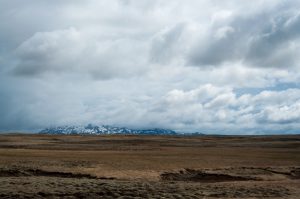
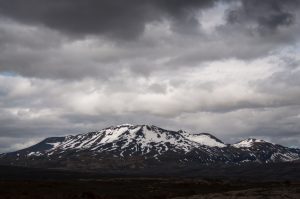
I’m leaving on a jet plane
All my bags are packed, I’m ready to go!
We’re just about ready for departure. Three of us leave this afternoon for flights out of Chicago, and the rest of the crew departs early tomorrow morning: Earlham –> IND/DAY –> JFK (7 hour layover) –> KEF –> Reykjavik!
It’s been a very busy 1.5 weeks, but, ready or not, we will all be in Iceland in less than 48 hours. We can anticipate cloudy weather in the 40s and 50s. We’re looking forward to experiencing another place, expanding our horizons (culturally, scientifically, emotionally), eating fermented shark, implementing our algorithms and devices, going back to Skalanes, to run in Iceland, seeing birds (especially Puffins), geocaching, standing on a glacier (and possibly sledding down it), climbing a volcano or two, lounging in a hot spring, and trying to learn some of the language.
Our gear is packed.
Our daily plans have been formulated.
Our devices are primed and charged.
Our sense of adventure is fully present.
Our Spotify playlist has been populated. What more do we need?
See you in Iceland!
Hey, DNA!
Our biology and soil team has begun a practice run of the sampling, DNA extraction, and MinION sequencing protocols so that we are prepared and familiar with the process before we get to Iceland. We started by collecting soil samples from various places around Earlham campus: The Heart, the Japanese garden by Stout, the horse barn, the rain garden by the Wellness Center, and a popular social gathering place back campus. We used Maria, one of our elevation platforms, to record the coordinates of each sample site, and as a placeholder for the soil temperature readings we will take in Iceland. We put the samples on ice to preserve the living organisms within, since we are trying to identify what kind of biotic activity takes place and varies at each site, both here at Earlham and eventually in Iceland on Sólheimajökull. Back at the lab, we extracted the DNA.
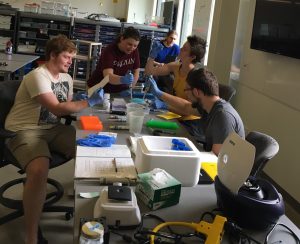
We also ran a gel electrophoresis and a Nano Drop to test the quality of the DNA. The former told us how long the strands were, and the latter told us how many nanograms per microliter of DNA we had in our samples. Both yielded positive results, meaning we have a good quality and quantity of DNA to put through the MinION.
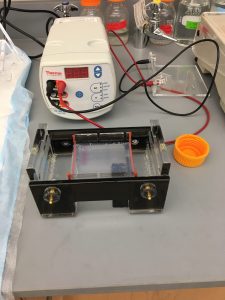
We had some technical difficulties at first with this new tech, but we made it work eventually and are now working on setting up the nanopore. We are almost ready to sequence the DNA and find out what microorganisms are living all around us! We had a great win the other day with QGIS. Though we had a rocky start, we were finally able to georeference our first map! Enthusiastic cheers echoed through the Turing room, and we all celebrated with a trip to Dairy Queen.
Laser Beams and Drones
Over the last few days, we have been making good progress with our LiDAR endeavors. Neil and Charlie have been working on weight-efficient methods to attach the LiDAR to our drone, Kia. The initial prototype was too heavy, and a test run over-heated Kia’s battery. It turns out that we can cover one of Kia’s sensors without catastrophe, which will allow us to attach the LiDAR to Kia underneath said sensor without needing extra material like a platform for the LiDAR to sit on.
It will be useful for us to sync up the LiDAR data with GPS data from Kia. Fortunately, both the LiDAR and Kia transmit time-data. Unfortunately, that data is not easily accessible, much less synchronizable. Kellan and Nic have been working on methods to extract this data so we can sync up and get going. They have also been working on installing software and writing code for analyzing point clouds (3-D depictions of LiDAR readings).
I have been familiarizing myself with the tools and methods used for analyzing point clouds. Once we have gathered our LiDAR data, how do we extract meaning from any of it? First we will need to reduce noise, which can be done by using statistical analysis to detect outlier points (laser reflects off of a piece of airborne dust, for instance). Since we will be looking for particular kinds of things (archaeological ruins, bird nests, etc.), we will then need to have methods for detecting particular features. For example, the foundation of a structure will likely have near-straight lines. If we have a tool that will highlight all near-straight lines, we can search for archaeological ruins more efficiently. There are many object-detection techniques, all of which involve very clever math. If we’re lucky, any noise-filtering and object-detection algorithms that we may need are already out there. If not, enough work has been done in this field that synthesizing existing methods will (hopefully) be doable.
We are currently searching for a renegade tablet that seems to have wandered off. I can’t imagine it can run very fast or far, so we should come across it soon if it doesn’t get tired and come home by itself.
Biology and Pockets
Lately we’ve been trying to figure out how to track the movement of the Sólheimajökull glacier to determine where to take samples of the soil, which we are then going to extract microbe DNA and thenot sequence that DNA with the MinION (as seen previously in the blog post wherein Emi was being very excited about her new gadget.) Moving away from the maps, we’ve passed the location torch to Dan and Ai Lena and georeferencing software, QGIS, as I found through several hours of soul crushingly fruitless work to get our three maps to the same scale that the analog method was not the best route. However with that issue off my plate, I am freed to work on honing my soil sampling, protocol following, and biology learning skills. So yesterday, for example, Dan, Cait, and I worked on practicing our pipetting so today we can gather soils from around campus to do a practice run of our DNA extraction kit and presumably the sequencing kit as well. I also learned that bacteria and archaea are different, also that I have a pocket that combines three pockets in one.
